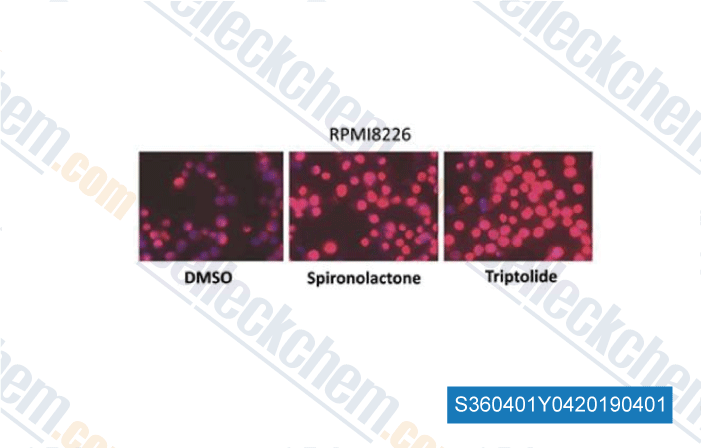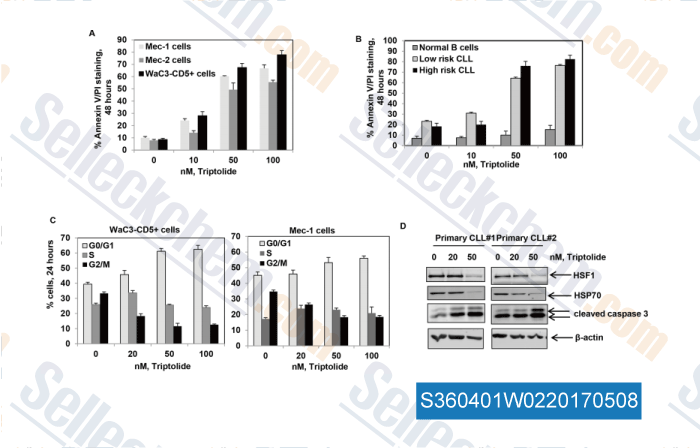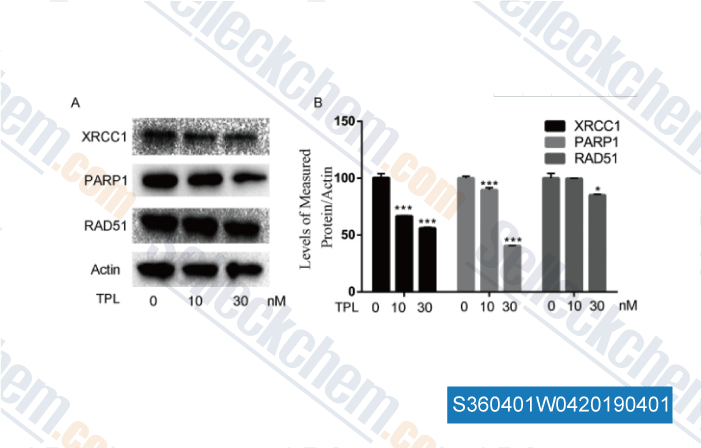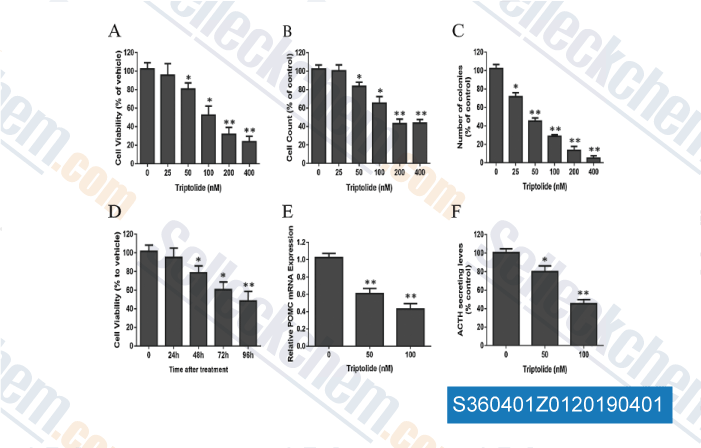|
Toll Free: (877) 796-6397 -- USA and Canada only -- |
Fax: +1-832-582-8590 Orders: +1-832-582-8158 |
Tech Support: +1-832-582-8158 Ext:3 Please provide your Order Number in the email. |
Technical Data
| Formula | C20H24O6 |
||||||
| Molecular Weight | 360.4 | CAS No. | 38748-32-2 | ||||
| Solubility (25°C)* | In vitro | DMSO | 72 mg/mL (199.77 mM) | ||||
| Water | Insoluble | ||||||
| Ethanol | Insoluble | ||||||
| In vivo (Add solvents to the product individually and in order) |
|
||||||
|
* <1 mg/ml means slightly soluble or insoluble. * Please note that Selleck tests the solubility of all compounds in-house, and the actual solubility may differ slightly from published values. This is normal and is due to slight batch-to-batch variations. * Room temperature shipping (Stability testing shows this product can be shipped without any cooling measures.) |
|||||||
Preparing Stock Solutions
Biological Activity
| Description | Triptolide is a diterpene triepoxide, immunosuppresive agent extracted from the Chinese herb Tripterygium wilfordii. It functions as a NF-κB inhibitor with dual actions by disruption of p65/CBP interaction and by reduction of p65 protein. This compound abrogates the transactivation function of heat shock transcription factor 1 (HSF1). It inhibits MDM2 and induces apoptosis through a p53-independent pathway. | |||
|---|---|---|---|---|
| Targets |
|
|||
| In vitro | Triptolide is a diterpene triepoxide with potent immunosuppressive and antiinflammatory properties. This compound is shown to inhibit the expression of IL-2 in activated T cells at the level of purine-box/nuclear factor and NF-κB mediated transcription activation. [1] It inhibits the proliferation and colony formation of tumor cells at extremely low concentrations (2–10 ng/mL). This chemical has an inhibitory activity on breast, stomach and leukemia cell line HL-60 cells. It induces apoptosis in tumor cells by blocking NF-κB activation and sensitizing tumor cells for TNF-&alpha induced programmed cell death. [2] | |||
| In vivo | Triptolide synergizes with cyclosporin A in promoting graft survival in animal models and in suppression of graft versus host disease in allogeneic bone marrow transplants. In addition, it induces apoptosis in tumor cells and potentiates tumor necrosis factor (TNF-α) induction of apoptosis in part through the suppression of c-IAP2 and c-IAP1 induction. [1] [3] This compound treatment for 2–3 weeks inhibits the growth of xenografts formed by four different tumor cell lines (B16 melanoma, MDA-435 breast cancer, TSU bladder cancer, and MGC80-3 gastric carcinoma), indicating that TPL has a broad spectrum of activity against tumors that contain both wild-type and mutant forms of p53. In addition, it inhibits experimental metastasis of B16F10 cells to the lungs and spleens of mice. [2] It has in vitro and in vivo activities against mouse models of polycystic kidney disease. [4] LD50: Mice 0.83mg/kg (i.v.). [5] |
Protocol (from reference)
References
|
Customer Product Validation

-
Data from [ , , Leukemia, 2018, 32(1):111-119 ]

-
Data from [ , , Oncotarget, 2015, 6(31):31767-79 ]

-
Data from [ , , Biomed Pharmacother, 2019, 109:1541-1546 ]

-
Data from [ , , Biomed Pharmacother, 2017, 95:771-779 ]
Selleck's Triptolide Has Been Cited by 48 Publications
| Chromatin-bound U2AF2 splicing factor ensures exon inclusion [ Mol Cell, 2025, S1097-2765(25)00316-8] | PubMed: 40315850 |
| Chromosomal tethering and mitotic transcription promote ecDNA nuclear inheritance [ Mol Cell, 2025, 85(15):2839-2853.e8] | PubMed: 40614723 |
| Triptolide targets PPP2CA/ITGA5 axis to suppress lactate-driven ovarian cancer progression [ Chin Med, 2025, 20(1):122] | PubMed: 40770810 |
| Triptolide and its prodrug Minnelide target high-risk MYC-amplified medulloblastoma in preclinical models [ J Clin Invest, 2024, 134(15)e171136] | PubMed: 38885332 |
| Dormant cancer cells and polyploid giant cancer cells: The roots of cancer recurrence and metastasis [ Clin Transl Med, 2024, 14(2):e1567] | PubMed: 38362620 |
| HIRA protects telomeres against R-loop-induced instability in ALT cancer cells [ Cell Rep, 2024, 43(11):114964] | PubMed: 39509271 |
| Targeted inhibition of the HNF1A/SHH axis by triptolide overcomes paclitaxel resistance in non-small cell lung cancer [ Acta Pharmacol Sin, 2024, 10.1038/s41401-023-01219-y] | PubMed: 38228910 |
| DEAD-box helicase 1 inhibited CD8+ T cell antitumor activity by inducing PD-L1 expression in hepatocellular carcinoma [ Cancer Sci, 2024, 10.1111/cas.16076] | PubMed: 38243657 |
| DEAD-box helicase 1 inhibited CD8+ T cell antitumor activity by inducing PD-L1 expression in hepatocellular carcinoma [ Cancer Sci, 2024, 115(3):763-776] | PubMed: 38243657 |
| Triptolide, a Cancer Cell Proliferation Inhibitor, Causes Zebrafish Muscle Defects by Regulating Notch and STAT3 Signaling Pathways [ Int J Mol Sci, 2024, 25(9)4675] | PubMed: 38731894 |
RETURN POLICY
Selleck Chemical’s Unconditional Return Policy ensures a smooth online shopping experience for our customers. If you are in any way unsatisfied with your purchase, you may return any item(s) within 7 days of receiving it. In the event of product quality issues, either protocol related or product related problems, you may return any item(s) within 365 days from the original purchase date. Please follow the instructions below when returning products.
SHIPPING AND STORAGE
Selleck products are transported at room temperature. If you receive the product at room temperature, please rest assured, the Selleck Quality Inspection Department has conducted experiments to verify that the normal temperature placement of one month will not affect the biological activity of powder products. After collecting, please store the product according to the requirements described in the datasheet. Most Selleck products are stable under the recommended conditions.
NOT FOR HUMAN, VETERINARY DIAGNOSTIC OR THERAPEUTIC USE.
